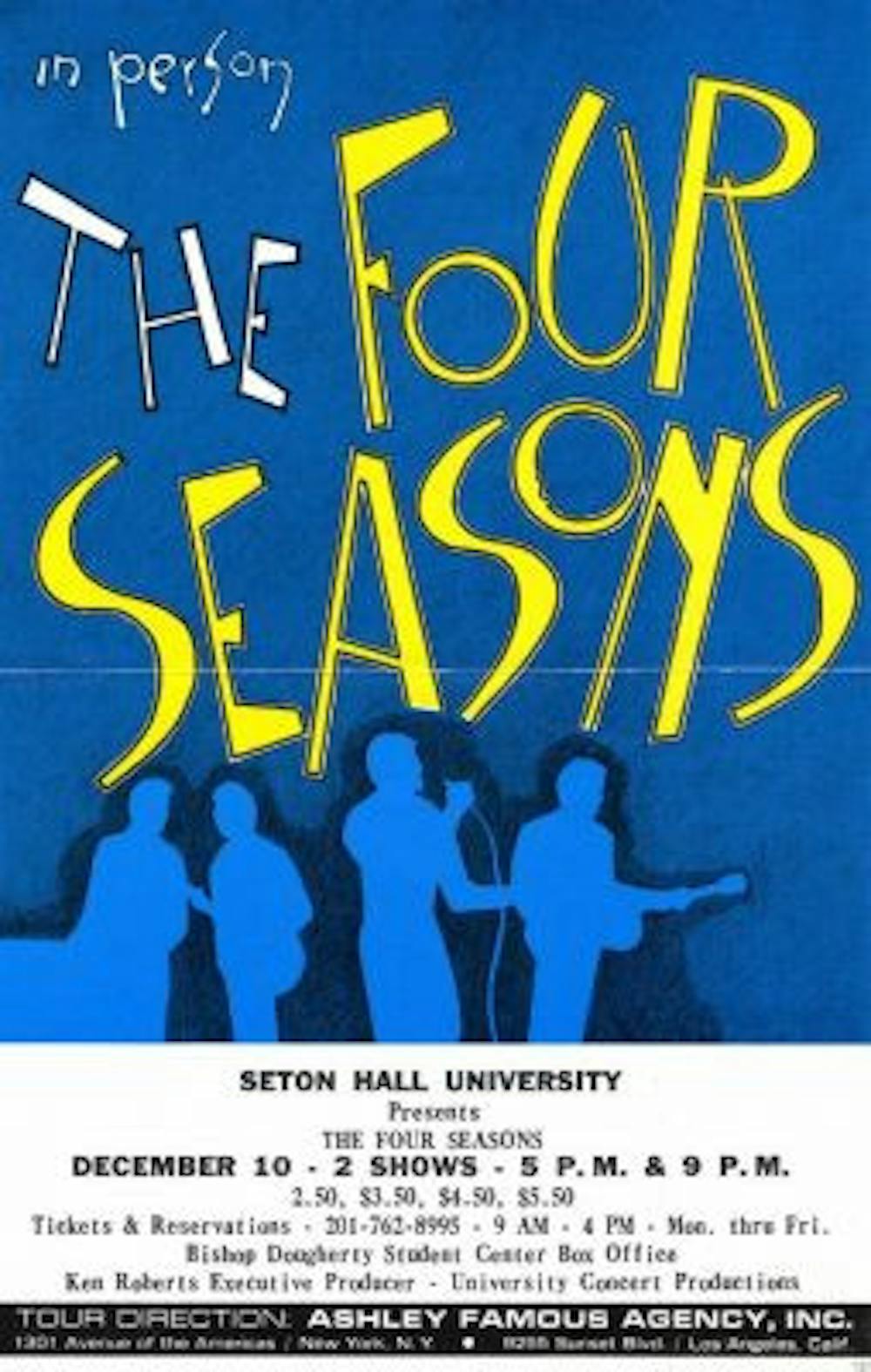On display this fall in the Walsh Gallery is the “Setonia in Stage and Song South Orange and New Jersey Perspectives” exhibit, which features memorabilia that commemorates Seton Hall’s past students, groups and musical appearances. The collection represents Seton Hall while also showing the artistic ties the University has with South Orange.
The exhibit contains a wide range of pictures, posters and playbills beautifully arranged on three shelves, with each shelf containing 200 years of the University’s history.
[caption id="attachment_20199" align="aligncenter" width="254"] Some of the memorobilia in the Setonia Stage and Song Exhibit includes a poster from the Four Seasons’ visit to SHU .
Some of the memorobilia in the Setonia Stage and Song Exhibit includes a poster from the Four Seasons’ visit to SHU .
Photo courtesy of Alan Delozier[/caption]
Seton Hall archivist Alan Delozier created the exhibit after years of Seton Hall students and alumni vocalizing their interest in the famous performers from SHU’s history. Delozier and other archivists worked for months curating memorabilia that showcases the Hall’s background. They employed a collaborative effort by reaching out to alumni and using items that have been previously collected to put on display.
“It is a fortune and pleasure for everyone to see,” Delozier said.
The memorabilia is from 1862 to the early 2000s, the most dated archive a poster calling Seton Hall students to assemble for celebrating George Washington’s birthday in 1862.
Stephanie Nwaiwu, a junior sports management major, said, “The exhibit shows students at the University that Seton Hall has had an amazing past, not just educationally but culturally.”
In the exhibit there is also a photocopy of a list of electives being offered at the University around 1860, two of them theater and music. These classes sparked interest among the male student body and created the Dramatic Society of Seton Hall, which often collaborated with the College of Saint Elizabeth.
A photograph in the exhibit showcases the Dramatic Society, an organization that produced plays for holidays as well as church and school celebrations, collaborating with the College of Saint Elizabeth for a play. The Dramatic Society went on to create and perform plays and musicals that prominent actors blossomed from. Some of the most captivating actors that attended Seton Hall include brothers John Barrymore (1882-1942) and Lionel Barrymore (1878-1954), whose pictures can be viewed in the exhibit.
The 19th century held a cultural revolution for Seton Hall that lasted well in to the 20th century. Becauase of this revolution, Seton Hall’s passion for the arts grew stronger and spread amongst the students.
SHU was noted for its astounding Seton Hall Orchestra, pictured in the exhibit from 1927, and Glee Club. By 1940, the Hall also built a strong radio broadcasting group, of which pictures are also on display, which kept the musical culture alive throughout the air waves of New Jersey.
The University has also hosted a number of musical artists during the last half century. Posters featured in the exhibit show prices and times for concerts featuring the Four Seasons (1967), Dionne Warwick (1970) and Bruce Springsteen (1974).
However, musicians were not the only performers in the Walsh Gym. The University hosted many Broadway shows in the gym, most notably, the award winning The Most Happy Fella, whose poster can be viewed in the exhibit as well.
Seton Hall University’s artistic groups have endured throughout the years and modernized with the times. The Drama Society morphed into “Theater-in-the-Round,” the theater group familiar to most students. The student group has notably performed at South Orange’s Performing Arts Center (SOPAC), strengthening the University’s ties to the town.
A poster from the Theater-in-the-Round summer of 1966 offering entertainment opportunities for students is available to view in the exhibit as well as photos of casts from past performances.
Merinda Gruszecki, a junior public relations major said, “Most students will go through school and have no idea about their school’s past. And this exhibit just showed me so much about my University that I had no clue about.”
Delozier, along with other archivists and donations from alumni, have helped to create an exhibit that will allow past and present students to enjoy their alma mater’s history. The exhibit will be taken down in early January 2018 and replaced with an exhibit focusing on French painters Margueritte Louppe and Maurice Brianchon.
Zoey Dotson can be reached at zoey.dotson@student.shu.edu





